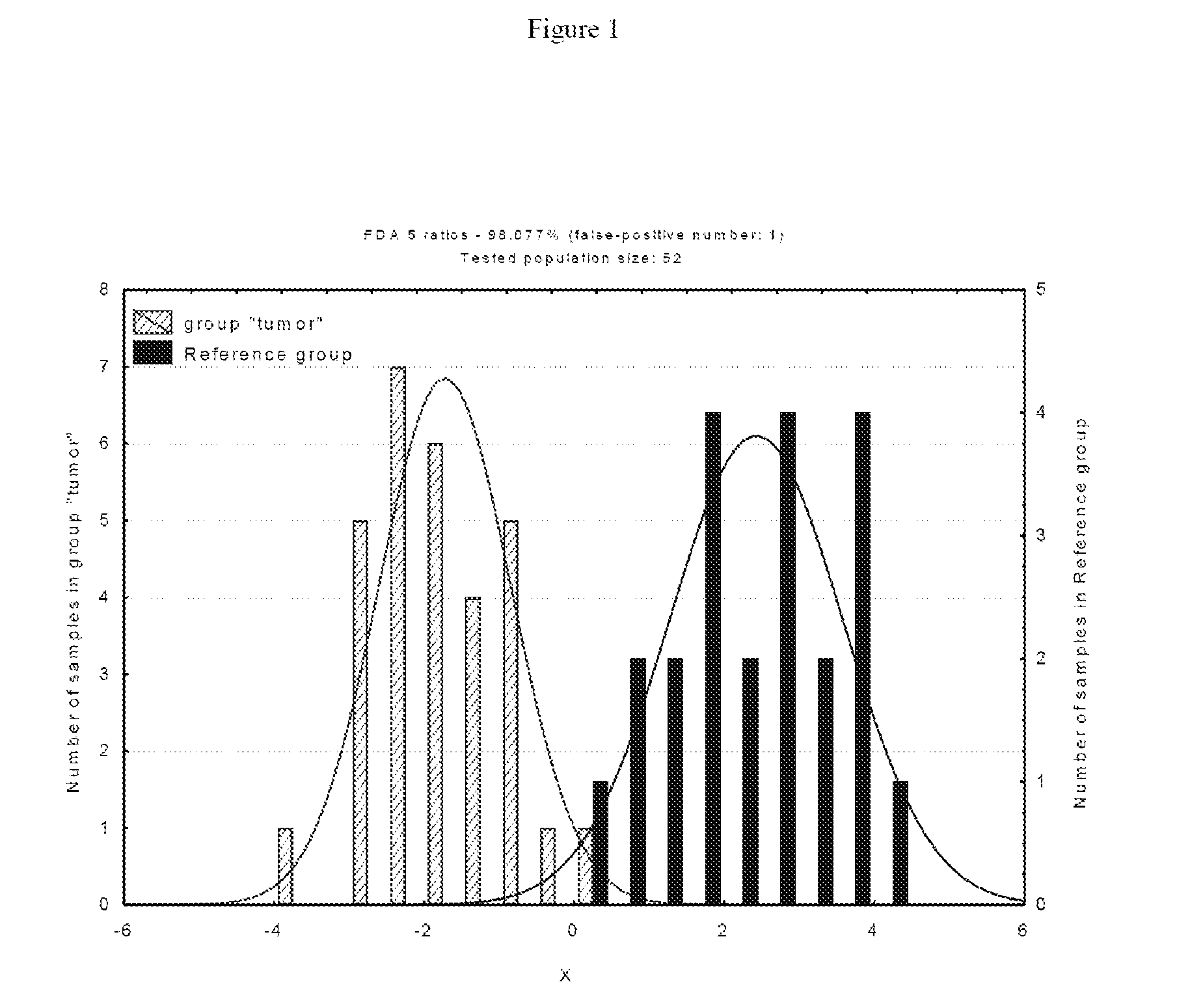Method of evaluating cancer risk in human
a cancer risk and human technology, applied in the field of human cancer risk evaluation, can solve the problems of increasing the risk of most varieties of cancer, unpleasant for patients to undergo existing diagnostic tests for cancer, and poor association of oral cancer risk of particulate bacteria strains
- Summary
- Abstract
- Description
- Claims
- Application Information
AI Technical Summary
Problems solved by technology
Method used
Image
Examples
example 2
Analysis of Organic Volatile Compounds in the Volatile Fraction of Saliva
[0102]It is known for a while that volatile compounds can be extracted from fluidic samples from oral cavity giving the possibility to explore the saliva as material to be analyzed for pathogenic diseases (Volozhin et al. Stomatologiia (mosk), 2001; 80(1):9-12).
[0103]In the present case, 1 ml of saliva solution is placed in a glass vial with 10 μL of the standard solution with 1 ppm of three (3) standards (1-bromobutane, 1-bromobenzene and 1.4-dibromobenzene; final solution with 1 ppm prepared in pure water).
[0104]The samples are placed at room temperature during at least 1 hour before analyzes. The sample is heated at 40° C. during 10 minutes then the extraction of the volatile compounds is carried out at 40° C., using a CAR / PDMS fiber (SPME fiber assembly CAR / PDMS of 75 μm (Supelco, Bellefont, Pa., USA)), during 30 minutes. Then the analysis was performed using GC / MS. The GC injection port temperature is 280°...
example 3
Quantification of the Identified Volatile Compounds in Cancer / Healthy Patients
[0112]The quantification of the volatile compounds is made by comparison with standard controls that have been added in the preservation buffer at the beginning of the experiment. In this case, the followings molecular standards have been used:[0113]1-bromobutane (CAS number 109-65-9)[0114]1-bromobenzene (CAS number 108-86-1)[0115]1,4-dibromobenzene (CAS number 106-37-6)
TABLE 3Particular biomarkers indicative of oral cancer predispositionOverexpressionOverexpressionin oral cancerin normalBiomarker namepopulationpopulation2,3-pentanedione6.00 X3-methyltiophene1.50 Xacetone2.30 Xhexanitrile3.00 Xbenzaldehyde1.80 X3-methyl-2-pentanone2.10 X2,3-butanedione4.40 X2-propanol2.80 Xethyl acetate3.90 X1-propanol1.90 Xhexanal1.60 X5-methyl-3-hexen-2-one1.70 Xm- and p-xylene1.50 X2-methyl-2-butenal (E)1.90 X2-methyl-2-butene2.00 X2-methyl-1-3.30 Xpropene(cis) 1,2-dimethyl1.70 Xcyclopropane
[0116]It has been concluded f...
example 4
Statistical Analysis of the Presence of Biochemical Organic Compounds in the Saliva of Oral Cancer Patient Vs Healthy Individuals
[0117]Software STATISTICA version 8.0 of StatSoft France (2007) is used for data analysis. The significances of the differences between the groups were tested by from Factorial Discriminating Analysis (FDA). Thus the similarities or the differences of the samples can be visualized graphically.
[0118]The identification of the volatile molecules is obtained by:[0119]Comparison of the experimental indices of retention to those of the internal data bank,[0120]comparison of the experimental spectra to those of the bank Wiley 275K and NIST 2.0d, built April 2005.
[0121]Statistical Model 1
[0122]Total population tested is 45 human subjects from two distinctive environmental geographic areas. Oral cancer population is confirmed by visual diagnostics performed by an anticancer center.
[0123]The statistical analyzes were carried out on 109 volatile compounds. Abundances...
PUM
 Login to View More
Login to View More Abstract
Description
Claims
Application Information
 Login to View More
Login to View More - R&D
- Intellectual Property
- Life Sciences
- Materials
- Tech Scout
- Unparalleled Data Quality
- Higher Quality Content
- 60% Fewer Hallucinations
Browse by: Latest US Patents, China's latest patents, Technical Efficacy Thesaurus, Application Domain, Technology Topic, Popular Technical Reports.
© 2025 PatSnap. All rights reserved.Legal|Privacy policy|Modern Slavery Act Transparency Statement|Sitemap|About US| Contact US: help@patsnap.com


